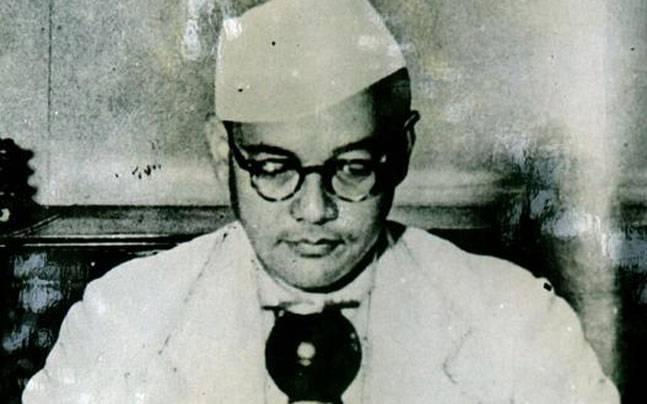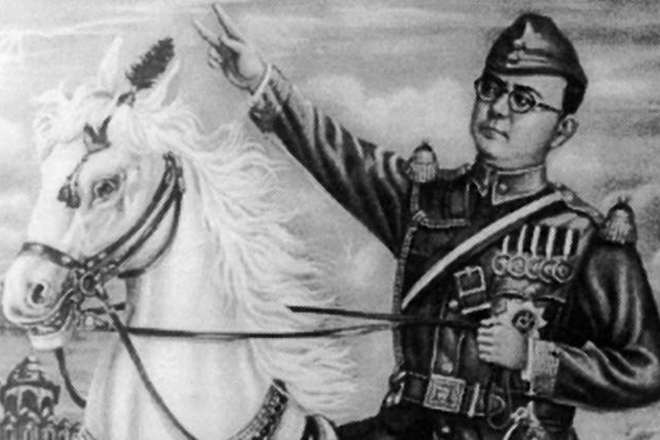
“When you go back to the country, tell the people that up to the last I have been fighting for the liberation of my country; they should continue to struggle, and I am sure India will be free before long. Nobody can keep India in bondage now.’’ were Netaji’s last words to Rahman at the Nanmon Military hospital.
On the morning of 18th August 1942, Bose, in his now trademark-INA cap, khaki bush shirt, and trousers got into a Mitsubishi Ki-20 bomber and resumed the journey to Tokyo from Saigon. At 2 pm they had landed at Matsuyama aerodrome in Taihoku, Formosa- today’s Taipei, Taiwan. The nose wheel again lifted off the ground at 2.30 pm. Just as the plane completed its climb, the propeller and the port engine fell off. Within a few seconds, the plane plunged 300 feet and impacted the ground at nearly 300 kmph with finally hitting a heap of rubble. According to his companion Habibur Rahman, Netaji got a splash of petrol all over his cotton Khaki which caught fire when he was trying to deplane. And then what Rahman witnessed from a distance of about 10 yards was a rolling ball of fire.

But the world was not ready to give such an easy adieu to one of India’s bravest son who had been the crux of the matter for Allies. This news was then released to the world through the Japanese news agency Domei on 23rd August 1945. It felt like a hammer blow in Kolkata, which was explicit in the local and national papers. Nehru’s and Gandhi’s mixed reactions and reports of Bose being spotted created a fuss in various Intelligence agencies across the world. Rahman and others, when returned to India were interrogated by officials fed with regular inputs. All this information summed up to two possibilities: Bose was on his way to Tokyo to discuss final arrangements to get some help from Russians. Another piece of information said that Bose had been trying to go to Tokyo just to discuss surrender. But the four iron boxes of gold that they took with them in their journey to Tokyo raised quite a few brows on Bose’s intention to return back. The much-awaited pictures taken by the Japanese at the crash-site failed to show his body with the State department confirming the lack of evidence for Bose’s plane accident. Although many of Netaji’s confidants remained consistent in their statements, few others broke the ranks to talk freely and laid bare Bose’s intentions to make a getaway to Russia. As the 1940s closed, the controversy about him being alive remained as a strong undercurrent with reports coming in from Siberia and Russia.
After the Figgess Report which conformed to Bose’s death, India appointed Shah Nawaz Commission (1956). One of the highlights of Shah Nawaz Commission was, the testimony of a nurse who corroborated the evidence recorded by Figgess. However, this committee was criticized for not visiting Taihoku and failing to explain the appearance of a Saradananda Sadhu in North Bengal during the 60s. Thus, in 1970 GOI formed the Khosla Commission but nothing new came out in this report except some new ‘sightings’ of Bose. These direct inquiries at home and abroad were not accepted by many Indians and therefore, the Vajpayee government appointed the Mukherjee commission in 1999. After a decade and a half long investigation, it concluded that there was no plane crash at Taihoku on 18th August 1945 with a secret plan to ensure Bose’s safe corridor to the USSR with the knowledge of Japanese authorities and Rahman. The report also stated that the ashes at Renkoji temple were not of Netaji and that Gumnaami Baba was different from Subhas Chandra Bose in light of the DNA-profiling test. But this report has been criticized in lieu of certain glaring accuracies when tabled in the Indian Parliament in May 2006.

As a result, the freedom fighter’s fate continued to be one of India’s unresolved political mysteries. Three inquiries have failed to put the issue to rest with the classified ‘Netaji Files’ being held back by the Prime Minister’s Office from Pandit Nehru to Manmohan Singh due to reasons dating back to India’s independence. However, Narendra Modi pressed a button at the National Archives in New Delhi to release 100 classified Netaji files in continuation of the government of West Bengal releasing all the “secret files” from its state archives. Finally, on 2nd March 2016, the government declared that all ‘Netaji files’ have been declassified. The efforts made by the current regime were commendable although Congress was of the opinion that actions of BJP were attempts to show the Old Party in poor light than paying homage to Bose. Then, in a response to an RTI query filed by Sayak Sen, Ministry of Home Affairs (MHA) has reportedly commented: “After considering the reports of the three commissions, the Government has come to the conclusion that Netaji has died in a plane crash in 1945.’’ Sen had also questioned the government about Gumnaami Baba or Bhagwanji who was rumored to be Netaji. “Mukherjee Commission had come to the conclusion that Gumnami Baba/Bhagwanji was not Netaji Subhas Chandra Bose. MHA has declassified all available files relating to Netaji,’’ it said. Netaji’s family lashed out at the government for the RTI reply. “This is highly irresponsible… How can the Centre give such a reply at a time when the matter is still pending,” replied Chandra Kumar Bose, Netaji’s grandnephew, and a BJP leade.
Even after half a century and more, there’s no rest regarding Netaji’s sudden disappearance, a man who defied Gandhi ; the one whom the world listened to yet, the politics over his death still goes on.
Written by: Soumyaseema Mandal

